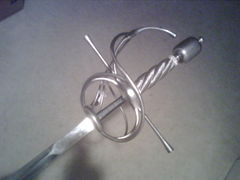Nair
| Total population | |||
|---|---|---|---|
| 5,000,000 (14.89% of Kerala population)[1] | |||
| Regions with significant populations | |||
|
|
|||
| Languages | |||
|
Malayalam |
|||
| Religion | |||
| Related ethnic groups | |||
|
Nambudiri, Bunt, Samantha Kshatriya |
Nair (pronounced /naːjar/ Malayalam: നായർ Nāyar, also known as Nāyar[2] and Malayala Kshatriya[3][4]), is a name of one of the Hindu forward caste from the Indian state of Kerala. Before the British conquest in 1792, the Kerala region contained small, feudal kingdoms, in each of which the royal and noble lineages, the militia, and most land managers were drawn from the Nairs and related castes.[5] Nairs were prominent in politics, government service, medicine, education, and law.[6] Nairs constituted the rulers, warriors and landed gentry of Kerala (pre Indian independence).
Nairs were traditionally matrilineal, which means that the family traces its roots through the women in the family. The children inherited the property of their maternal family. Their family unit, the members of which owned property jointly, included brothers and sisters, the latter's children, and their daughters' children. The oldest man was legal head of the group and he was respected as the Karanavar of the family or Tharavadu. Rules of marriage and residence varied somewhat between kingdoms.[7]
The Nairs are known for their martial history, including their involvement in Kalaripayattu and the role of Nair warriors in the Mamankam ritual. The Nairs were classed as a martial race[8][9][10][11] by the British and almost all the people in the British military were Nairs and reveived so many prizes from the British Authorities, but were de-listed after rebelling against them under Velu Thampi Dalawa, and thereafter were recruited in low numbers into the British Indian Army.[12] Only Nairs were recruited into the Thiruvithamkoor Nair Pattalam (Travancore State Nair Army), until 1935 when non-Nairs were admitted.[12] This State Force (known also as the Nair Brigade) was merged into the Indian Army after independence and became the 9th Battalion Madras Regiment, the oldest battalion in the Indian Army.
The Samanta Kshatriya Kolathiri and Travancore kingdoms[13] have Nair heritage[14] Herbert Wigram states that the Chirakkal Raja and the Travancore Raja belongs to branches of the same family and are representatives of the ancient Nāyar kings, perhaps the oldest aristocracy in the world.[15] The Zamorin Raja was a Samanthan Nair[13] and the Arakkal kingdom of Kannur, which was the only Muslim kingdom in the Kerala region, also had Nair origins[16][17][18]. Nair feudal families such as the Ettuveetil Pillamar of Travancore and Paliath Achan of Kochi were extremely influential in the past and exerted great influence on the ruling clan.
Contents |
Etymology
The word Nair lends itself to two etymological interpretations. The first interpretation is that the word Nair is derived from the Sanskrit word Nayaka meaning leader. The Sanskrit word Nayaka appears in various forms in southern India (Nayakan/Naicker in Tamil Nadu, Nayak in Karnataka and Maharashtra, and Nayudu in Andhra Pradesh) and the word Nair has been suggested to be the corruption of Nayak in Malayalam.[19][20][21] The second interpretation is that the word Nair is a corrupted form of the word Nāgar (serpent men).
Theories of origin
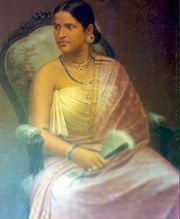
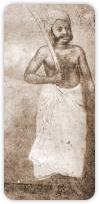
The earliest known description about Nairs state that Nairs (Nagars) are the descendants of the serpent caste soldiers sent by the Nāga Kingdom for taking part in the battle at Kurukshetra during Mahabharatha (Sources list a total of eight serpents - Vasuki, Ananta, Takshak, Sangapala, Gulika, Mahapadma, Sarkota and Karkotaka. Sree Padmanabhaswamy Temple is of special significance to the Nairs as it is believed to be the abode of Ananta and Nairs claim special powers due to the temple[22][23]). After the war, they encountered Parasurama who vowed to exterminate the Nāgas, since they were Kshatriya. The Nāgas transformed themselves to humans, ripped off their sacred chords, and fled the battlefield. After the Saka or Indo-Scythian people invaded India in the second century BC, some Nagas mixed with the Scythians in North India. They adopted the Matriarchy, Polyandry and other Scythian customs.[24] Nāga-Scythian tribe of Ahichatra, in Uttar Pradesh near Nainital was invited by King Mayuravarma of the Kadamba dynasty in 345 AD along with their Brahmin priests to settle down at Shimoga in the North Karnataka.[25][26][27]
They migrated Southwards and reached Malabar, where they fought with the Villavars and defeated them. Later they established their own kingdoms in Malabar and Tulu Nadu[28] The Nāgas finally reached Travancore, the Southern most part of India. There is still a sacred sarpakaavu (serpent grove) in Mannarsala (Travancore), which is owned by a Nayar family whose ancestors are said to be Nāga serpents spared when the Khandava Forest (in present day Punjab) was burnt down by Lord Krishna and Lord Arjuna.[29]
Mythology apart, Nairs are thought to be the descendants of Nagavanshi Kshatriyas, who migrated to Kerala from further North.[30] According to Dr K. K. Pillai, the first reference about the Nairs is in an inscription dated to the 9th century A.D.[31]
The Nairs have been described thus:
| “ | A race caste who do not owe their origin to function, although, by force of example, their organization is almost equally rigid, and they are generally identified with particular trades or occupations. These race caste communities were originally tribes, but on entering the fold of Hinduism, they imitated the Hindu social organization, and have thus gradually hardened to castes.[32] | ” |
A number of sociologists are of the view that the Nairs are not indigenous to Kerala, as many customs and traditions distinguish them from other Keralites. There is a hypothesis on the basis of mythology that the Nairs are Nagas, who were Kshatriyas belonging to the Serpent dynasty (Nagavansham)[33][34] who removed their sacred thread and migrated south to escape the wrath of a vengeful Parashurama. A Naga origin from Rohilkhand has been suggested.[35] The affinity of the Nair community towards serpent worship, their martial past, and the absence of the sacred thread lends support to this theory. In addition, the Travancore State Manual states that there were indeed serpent-worshiping Nagas in Kerala who fought with the Namboothiris till they reached a consensus. The Nairs have also been classified as of Indo-Scythian (Saka) origin as well as being linked to the Nagas.[36][37][38]
According to Chattampi Swamikal, who interpreted old Tamil texts, the Nairs were Naka (Naga or Snake) Lords who ruled as feudal lords in the Chera( chera= type of snake) kingdom. Therefore this theory proposes Nairs to be descendants of the rulers and martial nobility of pre-Brahmin Kerala. But the most widely accepted theory is that the ethnic group is not native to Kerala and the Nairs of Kerala and the similarly matrilineal Bunts of Tulu Nadu are thought to be descendants of the Kshatriyas who accompanied the Brahmins to Kerala and Tulu Nadu respectively from Ahichatra/Ahikshetra in southern Panchala.[39] One finds mention of the Nairs during the reign of the King Rama Varma Kulashekhara (1020–1102) of the second Chera dynasty, when the Chera Kingdom was attacked by the Cholas. The Nairs fought by forming suicide squads (Chavers) against the invading force. It is not clear whether the Cheras themselves were Nairs, or if the Cheras employed the Nairs as a warrior class.[40]
Connection with Bunts of Tulu Nadu
The 17th century Brahmin -inspired Keralolpathi of the Malayali brahmins and the Grama Padhati of Tulu brahmins describes the Nairs of Kerala and the similarly matrilineal Bunts of Tulu Nadu as descendants of Kshatriyas who accompanied the Brahmins to Kerala and Tulu Nadu respectively from Ahichatra/Ahikshetra in northern Panchala.[41].the remains of this city have been found in Ramnagar village in Aonla tehsil of Bareilly district in current Indian state of Uttar Pradesh[42]
The Manual of Madras Administration Vol II (printed in 1885) notes that the Kundagannada (kannada dialect) speaking Nadava or Nada Bunts are the same people as the Malayalam speaking Nairs of Malabar and the Tulu speaking Bunts of southern Tulu Nadu:
“ They appear to have entered Malabar from the North rather than the South and to have peopled first the Tulu, and then the Malayalam country. They were probably the off-shoot of some colony in the Konkan or the Deccan. In Malabar and south of Kanara as far as Kasargod, they are called Nayars and their language is Malayalam. From Kasargod to Brahmavar, they are termed as Bunts and speak Tulu. To the north of Brahmavar, they are called Nadavars, and they speak Kanarese. ”
The Nairs have disappeared as an entity from Tulu Nadu but the inscriptions found in Barkur from the medieval period as well as the Grama Padathi, which gives the history of Brahmin families in Tulu Nadu, have made several references to the Nairs. They seemed to have intimate connections with the Brahmins and acted as their protectors, perhaps brought to Tulu Nadu by the Kadamba kings in the 8th century. Kadamba king Mayuravarma, who is credited with bringing Brahmins from Ahichatra (from the north), also settled Nairs in Tulu Nadu and a mention of the Nair presence in tulu nadu in inscriptions comes after the Alupa period (early part of 14th century). Like the kings of Kerala some Bunt kings of Tulu Nadu also have Nair ancestry. For example, the last Bunt ruler of Kanajar in Udupi district was called Nayara Heggade.His palace Kanajar Doddamane though dilapidated in parts is undergoing restoration.[43][44] The royal house of the Bunts in Kowdoor (adjacent to Kanajar) is known as Nayara Bettu. Also "Nayara" is a surname among bunts. It is postulated that the Nairs in Tulu Nadu were later absorbed into the social stratum of the Bunt community. It is also postulated that the Nairs of Malabar originally migrated from Tulu nadu[2]
It is to be noted that the traditions and cultures of Nairs and Bunts are same to a large extent. Currently the Nairs who can trace their descent back to Tulunadu are concentrated in the Malabar region.[45]
Subcastes
Until a few decades ago, the Nairs were divided into several sub-castes and inter-dining and inter-marriages were practically non-existent amongst them. The 1891 Census of India, undertaken by the British listed a total of 138 Nair subcastes in the Malabar region, 44 in the Travancore region and a total of 55 of them in the Cochin region.[46]
Surnames
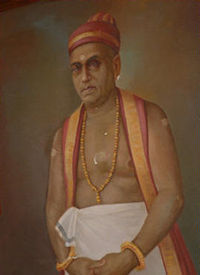
Most Nairs have the name of his maternal Tharavadu affixed to his name. Along with that, surnames are added to the names for further identification of the lineage. Several surnames are found among Nairs. Some surnames were conferred by the Kings for deeds of valour and services. Rajas of Cochin conferred on the Nairs the titles of nobility such as Achan, Kartha, Kaimal and Mannadiar. The title, Menon is used by the Nairs of Malabar and Cochin areas. The southern kingdoms of Venad (later extended as Travancore), Kayamkulam, Thekkumkur and Vadakkumkur conferred the titles such as Pillai, Thampi, Unnithan, and Valiathan on distinguished Nair families. Panikkar and Kurup were the titles of Nairs who maintained martial schools known as Kalaries. Surnames like Nambiar, Nayanar, Kitavu, and Menokki are seen only in North Kerala, where as "Nair" is a surname which is ubiquitous through out Kerala.
History

Middle age South Indian history, historians, and foreign travelers referred to the Nairs as a dignified martial nobility. The earliest reference to Nairs comes from the Greek ambassador Megasthenes. In his accounts of ancient India, he refers to the "Nayars of Malabar" and the "Kingdom of Chera".[47].
Irrespective of the different theories that seek to explain the origin of Nairs, it is clear that till the early 20th century, Nairs exerted their influence in medieval Kerala society as feudal lords and owned large estates. The position in society of the Nairs as that of a martial nobility in medieval Kerala has been likened to the position in society of the Samurai in medieval Japan. Nairs dominated the civil, administrative and military elite of the pre-British era in Kerala.[48][49][50][51][52][53][54][55]
Decline of Nair dominance
The decline of Nair dominance came about in multiple stages. During colonial times, the British perceived that Nairs were an inherent threat to their hegemony in the region and therefore outlawed their right to bear weapons and by banning the Kerala martial art of Kalaripayattu.[56][57] Weapons were integral to the Nair psyche and power, and combined with repressive legislation led to a loss of social standing for Nairs, though some of the social legislation was in part inspired by the Nairs themselves, such as changes in inheritance law permitting the Karanavan to pass on some (and later all) of the fruits of his stewardship of the taravad to his own children. During post-colonial years, the Land Reforms Ordinance of 1950's led to massive loss of land-ownership by Nair feudal lords and some Nair landed gentry were relegated to poverty overnight.
Nair Brigade

The Nair Brigade was the army of the erstwhile kingdom of Travancore in India. Nairs were a warrior community in the region which was responsible for the security of Travancore and other local kingdoms. King Marthanda Varma's (1706–1758) personal bodyguard was called 'Thiruvithamkoor Nair Pattalam' (Travancore Nair Army). The Travancore army was officially referred as the Travancore Nair Brigade in 1818.
Since independence, Malabar has been the most important recruitment ground for the Madras Regiment and Nairs constitute a huge proportion of the recruits from this area.[58] Although not as famous as Malabar Nayars, Nayars from Travancore and Cochin also constitute a significant portion of the Madras Regiment. Two former Travancore state army divisions, the 1st Travancore Nayar Infantry and the 2nd Travancore Nayar Infantry were converted in to 9th and 16th Battalions of Madras Regiment respectively after the independence. The Nayar army from Cochin was refurbished in to the 17th Battalion.[59]
Demographics
According to the 1891 Census of India, the total population of Nairs stood at 980,860 (Excluding subcastes like Maarans and Samanthan Nairs). Out of this, 483,725 (49.3%) lived in Travancore, 101,691 (10.4%) in Cochin and 377,828 (38.5%) in Malabar. The reminder were mostly found in Madras Presidency (15,939) and other parts of British India (1,677).[60]
The 1968 Socio-Economic Survey by the Government of Kerala gave the population of the Nair community as 14.41% of the total population of the state, constituting for 89% of the forward caste population in the state.
Customs and traditions
Religion
Along with the Namboothiris and Ambalavasis, Nairs formed the backbone for Hinduism in Kerala. Despite being thoroughly influenced by the Aryan traditions, remnants of the Nāga customs can still be found amongst the Nairs, such as Serpent worship. Sacred forests, where Naga Devatas (Serpent gods) are worshipped can be found in many Nair Tharavaads. These sacred forests are known as Sarpa Kavu (meaning Abode of the Snake God). Kavu and Kulam (Water Pond with stone-paved steps and boundary) were the attrributes of any flourishing Nair Tharavadu in the olden days. Nairs insisted on personal hygiene and so ponds were necessary. They performed daily worship by lighting the lamp at the Nagathara inside the Kavu. Reciting the names of gods and hymns in the evening in front of the Nila Vilakku (Sacred lamp) was religiously followed in every Nair Tharavadu. Nairs were the custodians of the temples in the respective Kara (area) and they regularly worshipped at the temples as well.
The staunch adherence to the Hindu faith among Nairs has resulted in a number of Nair - Muslim clashes, mostly in the Malabar region. Most notable among them are the Captivity of Nairs at Seringapatam[61], where thousands of Nairs were slaughtered by Muslims under Tippu Sultan. It is estimated that close to half of the total Nair population in Malabar perished during the 1766-1792 period, when Hyder Ali and Tipu Sultan invaded the region. Many more became refugees and fled to South Kerala. The defeat of the Nairs in Seringapatam resulted in the destruction of Hinduism in Southern Mysore region. However the Nairs of Travancore, with the help of the British were able to defeat the Muslim forces in 1792 at the Third Anglo-Mysore War[62]. A second conflict which happened during 1920s, known as the Moplah Riots culminated in mass murder of close to 30,000 Nairs[63] by Muslims and resulted in near complete exodus of Hindus from Malabar.[64]
However, due to their numerical superiority, the Nairs were able to hold on to the Hindu dominance in Travancore. Travancore is one of the very few areas in the entire India, where Muslim rule was never established. The opposition by Nairs to the Christian proselytizing activities has resulted in some minor altercations with Evangelical Christians in the Travancore region. Nair activists like Chattampi Swamikal strongly opposed Christian missionary activities and criticized Christianity.[65]
Attire
The attire of the Nair community was similar to that of the other forward castes in Kerala.
Cuisine
As is usual with Malayalees, par-boiled rice is the staple food of Nairs. Rice served may be in the form of Choru (boiled with water and drained) or in the form of rice gruel known as kanjee (pronounced /ˈkɒndʒiː/). Coconut, jackfruit, plantain, mango and other fruits and vegetables are widely used. Coconut oil is also used widely. Ghee is used on festive occasions. In earlier times, rice in the form of 'Kanji' or 'Choru' is served thrice a day at meal time along with curries and other additional dishes. Nowadays, breakfast has taken the form of snacks with Idli or Dosa which are actually Off-Kerala South Indian Items or Chapathi with curry which is North Indian or Bread with toast which is European.
Traditionally, the majority of Nairs, especially those belonging to the two largest subdivisions (Kiryathil Nair and Swaroopathil Nair) were not vegetarians, as consumption of fish was permitted. But subcastes like Illathu Nair, Maarar, Akathu Charna Nair, Purathu Charna Nair and Padamangalam Nair are strict vegetarians.[46] Chicken and mutton dishes are also prepared in many Nair homes nowadays, but they were prohibited earlier. Consumption of beef and alcohol is strictly prohibited and doing so often resulted in violence or excommunication during the pre-independence era. Among the vegetarian dishes, Aviyal, Thoran, and Theeyal are particularly Nair dishes. Ceremonial feasts are strictly vegetarian. Sweet dishes like Palpayasam and Ada Prathaman are prepared during ceremonial and festive occasions. Other special dishes included Kozhukkatta, Chivda, Elayappam (sweet), Ottada, Kaliyodakka, etc.[66].
Caste system
Nairs and Namboothiris were the topmost in Kerala's caste hierarchy.Kerala, referred to as a "lunatic asylum of castes" by Swami Vivekananda, had a system of untouchability and caste discrimination that was prevalent before the mid-20th century. Several social movements in India in the 19th and 20th centuries by Reformers and Spiritual leaders like Swami Vivekananda, Narayana Guru, Chattambi Swamikal etc.; dismantled the rigid caste barriers upheld among others, by the Nairs in Kerala.
- "A Nair was expected to instantly cut down a Tiar, or Mucua, who presumed to defile him by touching his person; and a similar fate awaited a slave, who did not turn out of the road as a Nair passed"[67]
According to Kerala tradition the Dalits were forced to maintain a distance of 96 feet from Namboothiris, 64 feet from Nairs and 48 feet from other upper castes (like Maarans and Arya Vysyas) as they were thought to pollute them.[68] Other castes like Nayadis, Kanisans and Mukkuvans were forbidden within 72 feet, 32 feet and 24 feet respectively from Nairs.[69]
Socio-political movements
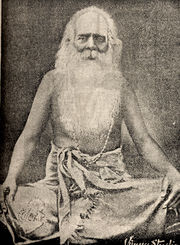
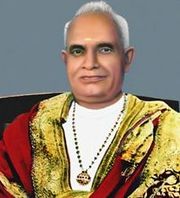
A number of socio-religious reform movements, which were also the earliest democratic mass movements in Kerala, took shape from late 1800s. The Nairs also felt the need for reform in response to such changes. Throughout the medieval period and until well into the 19th century, the Nairs had a pre-eminent role in Kerala. By the middle of the 19th century, however, this dominance started waning. Institutions like the sambandham and the matrilineal joint family system which had ensured the strength of the Nair community earlier, now became productive of many evils in changing socio-political background of Kerala. The impact of the market economy, the disappearance of traditional military training, the absorption of new values through the new system of education, the self-consciousness being generated among the lower castes and their cry for equality and privileges - all these factors brought about a decline of Nair dominance. The sense of decline gave an impetus to the spirit of reform that expressed itself in the work of religious men like Chattambi Swamikal, in literature, on the press and platform and later in legislative enactments in respect of marriage, inheritance, property rights, etc. Ultimately, the movements crystallized in the foundation of the Nair Service Society, in 1914. Vidhydhiraja Chattampi Swamikal attained Samadhi in Panmana Ashramam in Kollam District [1].
The Nair Service Society (NSS) is an organization created to represent the interests of the Nair community. It is headquartered at Perunna in the town of Changanassery in Kottayam District, Kerala State, India. It was established under the leadership of Mannathu Padmanabhan[70]. The NSS is a three tier organisation with Karayogams at the base level, Taluk Unions at the intermediate level and the Headquarters at the apex level.
The Society owns and manages a large number of educational institutions and hospitals. These include the NSS College of Engineering at Palakkad, NSS Hindu College at Changanassery, NSS College at Pandalam, Mahatma Gandhi College at Thiruvananthapuram, SVRVNSS College at Vazhoor, Pazhassi Raja NSS College at Mattanur, Kannur and the Women's College at Niramankara, Thiruvananthapuram. The N.S.S. runs more than 150 schools, 18 Arts and Science colleges, 3 Training colleges, 1 Engineering college, 1 Homoeo Medical College, several Nursing Colleges, Polytechnic college, T.T.C Schools, Working Women Hostels and Technical institutions.
Taking the lead given by Mannathu Padmanabhan, expatriate Nairs both in other states of India as well as in countries other than India have formed Nair Service Societies in their states and countries of domicile. Examples are Karnataka Nair Service Society with 21 karayogams in Bangalore, and the Calcutta Nair Service Society in Kolkata. Efforts are on to bring together all Nair groups the world over under an umbrella " International Federation of Nair Societies".
See also
- List of Nairs
- Forward Castes
- Samanta Kshatriya
- Kalarippayattu
- Bunts
- Nambiar
- Tharavadu
- Martial Race
- Naalukettu
- Samanthans
- Sambandham
- Kettu Kalyanam
- Maaran
- Panapillai Amma
- Jenmi
- Ettuveetil Pillamar
- Paliath Achan
- Caste system in Kerala
- Nair Brigade
- Battle of Colachel
- Mamankam
- Moopil Nair
- Velu Thampi Dalawa
Notes and references
- ↑ http://www.jstor.org/pss/4367366 Table 3:Percentage distribution of total land owned by communities - Proportion of households (1968)
- ↑ http://books.google.co.in/books?id=9mR2QXrVEJIC Malabar manual By William Logan
- ↑ http://books.google.co.in/books?id=AXN1Mq2WuYsC Page 5, Line 25
- ↑ http://books.google.co.in/books?id=NBG2AAAAIAAJ&pg=PA40 Page 40, Line 16
- ↑ "Nair." Encyclopædia Britannica. 2008. Encyclopedia Britannica Online. 5 June 2008
- ↑ Encyclopedia Britanica
- ↑ "Nāyar." Encyclopædia Britannica. Ultimate Reference Suite. Chicago: Encyclopædia Britannica, 2008.
- ↑ American Asiatic Association (1942). Asia: Asian Quarterly of Culture and Synthesis. Asia Magazine. p. 22.
- ↑ Paul Hartmann, B. R. Patil, Anita Dighe (1989). The Mass Media and Village Life: An Indian Study. Sage Publications. p. 224.
- ↑ Kumara Padmanabha Sivasankara Menon (1965). Many Worlds: An Autobiography. Oxford University Press. p. 2.
- ↑ Hugh Gantzer (April 1975-March 1976). Imprint. Business Press. p. 80.
- ↑ 12.0 12.1 http://www.keralapolicehistory.com/trvpol1.html
- ↑ 13.0 13.1 Nayar History and Cultural Relations
- ↑ The Eastern Anthropologist, Ethnographic and Folk-Culture Society (Uttar Pradesh, India), Lucknow University Anthropology Laboratory, 1958, p108
- ↑ http://books.google.co.in/books?id=3ecGANRRqssC&pg=PR6
- ↑ A. Sreedhara Menon (1967). A Survey of Kerala History. Sahitya Pravarthaka Co-operative Society. p. 204.
- ↑ N. S. Mannadiar (1977). Lakshadweep. Administration of the Union Territory of Lakshadweep. p. 52.
- ↑ Ke. Si. Māmmanmāppiḷa (1980). Reminiscences. Malayala Manorama Pub. House. p. 75.
- ↑ P. V. Balakrishnan (1981). Matrilineal System in Malabar. p. 27.
- ↑ Madras (Presidency) (1885). Manual of the Administration of the Madras Presidency. p. 100.
- ↑ The cyclopædia of India and of Eastern and Southern Asia, Edward Balfour, 1885, p249
- ↑ Imperial gazetteer of India: provincial series, Volume 18 p.436
- ↑ Temples of Kerala By S. Jayashanker, India. Directorate of Census Operations, Kerala. p.322
- ↑ Social History of Kerala: The Dravidians By L. A. Krishna Iyer
- ↑ The Kadambas By Phanikanta Mishra p.14
- ↑ Encyclopaedia of Hinduism, Volume 7 By N.K. Singh p.2715
- ↑ New light thrown on the history of India: the historical Naga kings of India By Narayan Gopal Tavakar
- ↑ Dr.D.D. Kosambi in An introduction to the Study of Indian History, (Bombay, 1956), p.113 - Nair: 1959: 11
- ↑ Social History of Kerala: The Dravidians By L. A. Krishna Iyer p.003
- ↑ Kishori Lal Fauzdar: Uttar Pradesh ke Madhyakalin Jatvansh aur Rajya, Jat Samaj, Monthly Magazine, Agra, September-October 1999
- ↑ K. Balachandran Nair (1974). In Quest of Kerala. Accent Publications. p. 117.
- ↑ James Hastings (2003). Encyclopedia of Religion and Ethics Part 5. Kessinger Publishing. p. 231.
- ↑ Downfall of Hindu India, Chintaman Vinayak Vaidya, 1986, p278
- ↑ Ramananda Chatterjee (1922). The Modern Review. Prabasi Press Private, Ltd.. p. 675.
- ↑ Jervoise Athelstane Baines (1893), General report on the Census of India, 1891, London, Her Majesty's Stationery Office, p. 184
- ↑ Ramananda Chatterjee (1907). The Modern Review. Prabasi Press Private, Ltd. p. 695.
- ↑ Raman Menon, K. "The Scythian Origin of the Nairs", Malabar Quarterly Review, Vol. I, No. 2, June 1902
- ↑ V. Nagam Aiya (1906). The Travancore State Manual. Princely State of Travancore. p. 348.
- ↑ http://nairsofkerala.blog.co.uk/2008/03/12/theories-of-origin-3860390/ Theory of origin
- ↑ The Nair heritage of Kerala: People and culture, keralaonlinetourism.com
- ↑ http://books.google.com/books?id=K0RHOwAACAAJ Maclean's Manual of the Administration of the Madras Presidency
- ↑ Lahiri, Bela (1972). Indigenous States of Northern India (Circa 200 B.C. to 320 A.D.), Calcutta: University of Calcutta, pp.170-88
- ↑ http://www.daijiworld.com/news/news_disp.asp?n_id=76466
- ↑ http://www.mangalorean.com/news.php?newstype=local&newsid=178348
- ↑ http://www.nairs.in/classifications.htm
- ↑ 46.0 46.1 http://www.jstor.org/stable/3629883 The Internal Structure of the Nayar Caste, C. J. Fuller
- ↑ Aiya, V. Nagam: "Travancore State Manual", pages 232, 238
- ↑ Indian Department of Tourism (1966). Mysore and Kerala. Indian Department of Tourism. p. 4.
- ↑ Neither Newton nor Leibniz, canisius.edu
- ↑ From Vedic Martial Arts to Aikido, veda.harekrsna.cz
- ↑ A travel feature on the ancient Kerala art of Kalaripayattu, rediff.com
- ↑ Kalaripayattu, the traditional martial art, enskalari.org.in
- ↑ John Keay (1999). Into India. University of Michigan Press. p. 75. ISBN 0472086359.
- ↑ Praxy Fernandes (1969). Storm Over Seringapatam: The Incredible Story of Hyder Ali & Tippu Sultan. Thackers. p. 35.
- ↑ Praxy Fernandes (1991). The Tigers of Mysore: A Biography of Hyder Ali & Tipu Sultan. Viking. p. 29. ISBN 0670839876.
- ↑ Ancient martial art fights for survival in India, findarticles.com
- ↑ Kalari, usadojo.com
- ↑ The book of Duarte Barbosa: an account of the countries bordering on the ... By Duarte Barbosa, Mansel Longworth Dames p.38
- ↑ Valour and sacrifice: famous regiments of the Indian Army By Gautam Sharma p.59
- ↑ The Internal Structure of the Nayar Caste, C. J. Fuller
- ↑ Prabhu, Alan Machado (1999). Sarasvati's Children: A History of the Mangalorean Christians. I.J.A. Publications. p. 250. ISBN 9788186778258.
- ↑ http://books.google.com/books?id=QIyz79F3Nn0C&pg=PA392&dq=Seringapatam&lr=&as_brr=3&client=firefox-a&sig=l_6_DAL_wD-FFzcOXZ8YQ8o4KBs
- ↑ O P Ralhan (1996). Encyclopaedia of Political Parties: India, Pakistan, Bangladesh : National, Regional, Local. Anmol Publications PVT . LTD.. p. 297.
- ↑ http://www.keepmilitarymuseum.org/malabar.php?&dx=1&ob=3
- ↑ Chattambi Swamikal, H.H.Vidhyadhiraja Parama Bhattaraka (1890). Kristumata Chedanam. Open Source Books. p. Chapter 1–4.
- ↑ Travancore State Manual 1906 by V Nagam Aiya, Vol II page 352
- ↑ http://books.google.com/books?id=FnB3k8fx5oEC&pg=PA291 Castes and tribes of Southern India, Volume 7 By Edgar Thurston, K. Rangachari, p.251
- ↑ http://sih.sagepub.com/cgi/reprint/9/2/187.pdf?ck=nck
- ↑ http://www.nairs.in/acha_a.htm
- ↑ V. Balakrishnan & R. Leela Devi, 1982, Mannathu Padmanabhan : and the revival of Nairs in Kerala, Vikas Publishing House, New Delhi
External links
- [2] Nair Service Society - Website
- [3] Nairs Information and Research Website
- [4] Digital Colonial Documents (India)
- Nair DNA Project
- [5] Chennai Nair Service Society
- [6] Adayar Nair Seva Society
- [7] Karnataka Nair Service Society
- [8] Canada Nair Service Society
- [9] Eranakulam Karayogam
- [10] Delhi NSS Karayogam
- [11] Abhedashramam, Thiruvananthapuram
|
|||||||||||||||||||||||||||||
